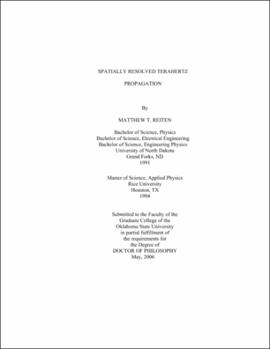| dc.contributor.advisor | Cheville, R. Alan | |
| dc.contributor.author | Reiten, Matthew T. | |
| dc.date.accessioned | 2013-12-10T18:05:51Z | |
| dc.date.available | 2013-12-10T18:05:51Z | |
| dc.date.issued | 2006-05 | |
| dc.identifier.uri | https://hdl.handle.net/11244/7871 | |
| dc.description.abstract | Scope and Method of Study: The focus of the research was to investigate the spatial behavior of near single cycle freely propagating terahertz radiation. The terahertz pulses were generated through optoelectronic means and the experimental systems based on established terahertz time domain spectroscopy techniques. By raster scanning the terahertz beam orthogonally to the optic axis with a fibercoupled reduced aperture receiver, the electric field of the beam could be directly measured. This system was used to investigate the propagation of a broad bandwidth pulse through an optical tunneling barrier comprised of a matched pair of high resistivity silicon prisms cut at an incident angle above critical angle. Spectral analysis through numeric Fourier transforms was used to interpret the behavior and test claims of superluminal (faster than the speed of light) propagation through an optical tunneling barrier. | |
| dc.description.abstract | Findings and Conclusions: Superluminal propagation does not occur in the case of frustrated total internal reflection. Linear dispersion theory, experimental evidence of a lateral beam shift (the Goos-Hanchen effect), and numeric simulation support the conclusion that propagation across an optical tunneling barrier is causal. Exposed receiver dipole antennas provide sufficient resolution to observe fine features in the propagating beam profile. The starting beam waist of the incident terahertz beam strongly influences the pulse profile after transiting an optical tunneling barrier. Standard silicon collimating lenses give rise to frequency dependent beam profiles due to interference caused by a complex temporal pulse structure. The complex pulse structure results from lens aberrations, antenna radiation patterns, and surface wave contributions. Aspheric lenses minimize the observed pulse structure due to spherical aberration and are a better choice of lens for measuring incident plane wave terahertz radiation. | |
| dc.format | application/pdf | |
| dc.language | en_US | |
| dc.rights | Copyright is held by the author who has granted the Oklahoma State University Library the non-exclusive right to share this material in its institutional repository. Contact Digital Library Services at lib-dls@okstate.edu or 405-744-9161 for the permission policy on the use, reproduction or distribution of this material. | |
| dc.title | Spatially resolved terahertz propagation | |
| dc.contributor.committeeMember | Grischkowsky, Daniel | |
| dc.contributor.committeeMember | Bunting, Charles | |
| dc.contributor.committeeMember | Wicksted, James | |
| osu.filename | Reiten_okstate_0664D_1808.pdf | |
| osu.accesstype | Open Access | |
| dc.type.genre | Dissertation | |
| dc.type.material | Text | |
| thesis.degree.discipline | Electrical Engineering | |
| thesis.degree.grantor | Oklahoma State University | |
